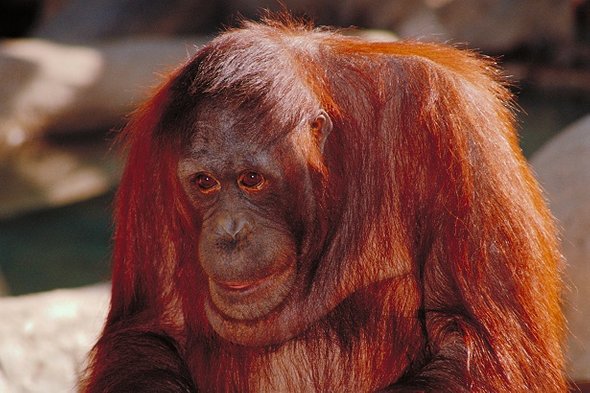(单词翻译:单击)
听力文本
Hi, I'm Scientific American podcast editor Steve Mirsky. Here’s a short piece from the May 2018 issue of the magazine, in the section we call Advances: Dispatches from the Frontiers of Science, Technology and Medicine:
Orangutan Medicine by Doug Main
Medicine is not exclusively a human invention. Many other animals, from insects to birds to nonhuman primates, have been known to self-medicate with plants and minerals for infections and other conditions. Behavioral ecologist Helen Morrogh-Bernard of the Borneo Nature Foundation has spent decades studying the island's orangutans and says she has now found evidence they use plants in a previously unseen medicinal way.
During more than 20,000 hours of formal observation, Morrogh-Bernard and her colleagues watched 10 orangutans occasionally chew a particular plant (which is not part of their normal diet) into a foamy lather and then rub it into their fur. The apes spent up to 45 minutes at a time massaging the concoction onto their upper arms or legs. The researchers believe this behavior is the first known example of a nonhuman animal using a topical analgesic.

Local people use the same plant—Dracaena cantleyi, an unremarkable-looking shrub with stalked leaves—to treat aches and pains. Morrogh-Bernard's co-authors studied its chemistry. They added extracts from the plant to human cells that had been grown in a dish and had been artificially stimulated to produce cytokines, an immune system response that causes inflammation and discomfort. The plant extract reduced the production of several types of cytokines, the scientists reported the finding in a study published last November in Scientific Reports.
The results suggest that orangutans use the plant to reduce inflammation and treat pain. Such findings could help identify plants and chemicals that might be useful for human medications.
In creatures such as insects, the ability to self-medicate is almost certainly innate; woolly bear caterpillars infected with parasitic flies seek out and eat plant substances that are toxic to the flies. But more complex animals may learn such tricks after an initial discovery by one member of their group. For example, an orangutan may have rubbed the plant on its skin to try to treat parasites and realized that it also had a pleasant pain-killing effect. That behavior may then have been passed on to other orangutans. Because this type of self-medication is seen only in south-central Borneo, Morrogh-Bernard says, it was probably learned locally.
That was Orangutan Medicine by Doug Main.
参考译文
大家好,我是《科学美国人》播客编辑史蒂夫·米尔斯基。以下是收录在本杂志2018年5月刊“进展:科学、技术和医学前沿快报”版块中的一篇短文。
《红毛猩猩的药》 作者:道格·梅恩
药物并不是人类的独家发明。从昆虫到鸟类再到非人灵长类动物,目前已知有很多其它动物都会用植物和矿物质来自我治疗感染和其他疾病。婆罗洲自然基金会的行为生态学家海伦·莫罗·伯纳德研究了婆罗洲红毛猩猩数十年,她现在发现这些猩猩以一种此前从未见过的治疗方法来使用植物治病。
在两万多个小时的正式观察中,莫罗·伯纳德和同事观察到10只红毛猩猩偶尔会咀嚼一种特殊植物,这种植物并不是它们的日常饮食,它们会将该植物嚼成泡沫然后擦在毛皮上。这些猩猩每次花45分钟在上臂和腿上揉擦这种调配品。研究人员认为这种行为是目前已知的非人类动物使用外用止痛药的首个案例。
当地人用同一种植物——龙血树,一种叶子长在茎上的不起眼灌木——来治疗疼痛。莫罗·伯纳德的合作作者研究了这种植物的化学成分。他们将龙血树提取物加入人类细胞中,这些人类细胞在培养器皿中培养,并通过人工刺激产生细胞因子,这是引发炎症和不适的一种免疫系统反应。龙血树提取物降低了多种细胞因子的产量,科学家将这一结果发表在《科学报告》2017年11月刊上。
研究结果表明,红毛猩猩用龙血树来减轻炎症和治疗疼痛。此类发现有助于识别可能对人类药物有用的植物和化学物质。
对昆虫这类生物来说,自我治疗能力几乎必然是天生的;被寄生蝇感染的灯蛾毛虫会寻求并食用对寄生蝇有毒的植物。但更复杂的动物可能是在群体中一名成员首先发现后,才学会这种诀窍。举例来说,一只红毛猩猩可能会用一种植物在皮肤上揉搓试图去除寄生虫,然后发现这种植物还有不错的止痛效果。之后,这种行为可能传给了其它红毛猩猩。莫罗·伯纳德表示,因为人们只在婆罗洲中南部地区看到过这种自我治疗,所以这很可能是种局部学习行为。
以上是道格·梅恩发表的文章《红毛猩猩的药》。
译文为可可英语翻译,未经授权请勿转载!
重点讲解
重点讲解:
1. rub into 涂抹;搽;擦去;
He rubbed oil into my back.
他往我的背上抹油。
2. add to 添加;增加;掺加;
Add the grated cheese to the sauce.
把磨碎的干酪加到调味汁里。
3. seek out 寻找到;找出;
Children seek out regularities and rules in acquiring language.
儿童在学习语言过程中会找出各种规律和规则。
4. pass on to 将…传给;将…交给;
Having read the book, she will be able to pass on the acquired knowledge to trainee teachers.
读完此书,她便能将从书中所得传授给实习教师。


